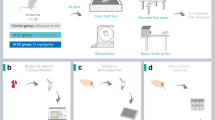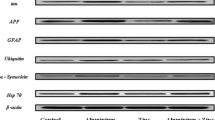Abstract
Human is exposed to traces of aluminum silicate (AlS), i.e., cosmetics, pesticides. Accumulation of aluminum compounds including AlS is associated with neuropathological diseases, e.g., Alzheimer’s disease. The aim of the current study is to investigate the neuroprotective effects of propolis extracts in AlS-induced cerebellum intoxication in rats. Forty adult rats were randomly divided into four groups (n = 10). The first group served as a control; the second group treated with 200 ml propolis/kg bwt. every other day by stomach gavage tube, third group was intraperitoneally injected with AIS (20 mg/kg) twice a week for 8 weeks, and the fourth group received propolis extract and AIS. At the end of 8 weeks, the cerebellum was harvested for further ultrastructure, histological, and histochemical investigations. Using electron microscopy, the ultrastructure of the cerebellar cortex of AlS intoxicated rats showed Purkinje cells with an irregular euchromatic nucleus and extremely increased invagination of the nuclear envelope. In addition, the cytoplasm revealed numerous damaged mitochondria (> 20%) as well as swollen lysosomes (> 40%) compared to controls. These AlS-related ultrastructure changes were to some extent normalized to < 10% and < 30% in case of mitochondria and lysosomes, respectively, if rats were co-treated with propolis extract. Further, histopathological examination showed that AlS-exposed rats revealed abnormal Purkinje cells with irregular size and shrank shape, evidence of pre-necrotic stage in the form of nuclear pyknosis, and condensed and frequent darkly stained cells in cerebellar layers. However, propolis extract co-administration reversed from 35 to 25% (p < 0.05) these alterations. The carbohydrate and protein contents were reduced in case of AlS treatment and surprisingly propolis co-treatment was able to rescue these neurotoxic effects. Propolis extract might have neuroprotective effects against AIS-induced toxicity. Further studies are required to identify the mechanism of the pharmacological action and optimal settings for medical testing of propolis extract.




Similar content being viewed by others
References
Ali D, Badr El-Din N, Abou-El-magd R (2015) Antioxidant and hepatoprotective activities of grape seeds and skin against Ehrlich solid tumor induced oxidative stress in mice. Egypt J Basic Appl Sci 2:98–109
Bakour M, Al-Waili NS, El Menyiy N, Imtara H, Figuira AC, Al-Waili T, Lyoussi B (2017) Antioxidant activity and protective effect of bee bread (honey and pollen) in aluminum-induced anemia, elevation of inflammatory makers and hepato-renal toxicity. J Food Sci Technol 54:4205–4212
Bancroft JD, Gamble M (2008) Theory and practice of histological techniques. In: Churchill Livingstone. Elsevier, China
Banin E, Meiri H (1990) Toxic effects of alumino-silicates on nerve cells. Neuroscience 39:171–178
Bosco D, Fava A, Plastino M, Montalcini T, Pujia A (2011) Possible implications of insulin resistance and glucose metabolism in Alzheimer’s disease pathogenesis. J Cell Mol Med 15:1807–1821
Clayden EC (1971) Practical section cutting and staining. Harcourt Brace/Churchill Livingstone, Edinburgh
Crookham HC (1991): Hazardous chemicals in the histopathology laboratory: regulations risks handling & disposal. ANATECH
Cunha I, Sawaya AC, Caetano FM, Shimizu MT, Marcucci MC, Drezza FT, Povia GS, Carvalho PO (2004) Factors that influence the yield and composition of Brazilian propolis extracts. J Braz Chem Soc 15:964–970
Dua R, Kumar V, Sunkaria A, Gill KD (2010) Altered glucose homeostasis in response to aluminium phosphide induced cellular oxygen deficit in rat. Indian J Exp Biol 48:722–730
El-Masry TA, Emara AM, El-Shitany NA (2011) Possible protective effect of propolis against lead-induced neurotoxicity in animal model. J Evol Bio Res 3:4–11
Esparza JL, Gomez M, Romeu M, Mulero M, Sanchez DJ, Mallol J, Domingo JL (2003) Aluminum-induced pro-oxidant effects in rats: protective role of exogenous melatonin. J Pineal Res 35:32–39
Exley C (1999) A molecular mechanism of aluminium-induced Alzheimer’s disease? J Inorg Biochem 76:133–140
Fischer AH, Jacobson KA, Rose J, Zeller R (2008): Hematoxylin and eosin staining of tissue and cell sections. CSH Protoc 2008, pdb prot4986
Hassanin LA, Salama AM, Essa EA, Abd El-Moniem M (2017) Potential role of some nutraceuticals in neurotoxicity induced by aluminum oxide in experimental animal model. International Journal of Advanced Research in Biological Sciences 4:72–89
Hendi NKK, Naher HS, Al-Charrakh AH (2011) In vitro antibacterial and antifungal activity of Iraqi propolis. J Med Plants Res 5:5058–5066
Hodson JJ, Prout RE (1968) Chemical and histochemical characterization of mucopolysaccharides in a jaw myxoma. J Clin Pathol 21(5):582–589
Hu F, Hepburn HR, Li Y, Chen M, Radloff SE, Daya S (2005) Effects of ethanol and water extracts of propolis (bee glue) on acute inflammatory animal models. J Ethnopharmacol 100:276–283
Julka D, Sandhir R, Gill KD (1995) Altered cholinergic metabolism in rat CNS following aluminum exposure: implications on learning performance. J Neurochem 65:2157–2164
Kamal I, Kamal H (2013) Effects of aluminum on rat cerebellar cortex and the possible protective role of Nigella sativa: a light and electron microscopic study. The Egypt J Histol 36:979–990
Kawahara M, Kato-Negishi M (2011) Link between aluminum and the pathogenesis of Alzheimer’s disease: The Integration of the Aluminum and Amyloid Cascade Hypotheses. Int J Alzheimers Dis 2011, 276393
Khalil FM, EL-Kirsh AAA, Kamel EA, EL-Rahmany NG (2016) Beneficial effect of propolis extract (bee glue) against methotrexate-induced stress in liver and brain of albino rats. Indian J Med Res Pharma Sci 3:24–35
Kocot J, Kiełczykowska M, Luchowska-Kocot D, Kurzepa J, Musik I (2018) Antioxidant potential of propolis, bee pollen, and royal jelly: possible medical application. Oxidative Med Cell Longev 2018:29
Kwon YS, Park DH, Shin EJ, Kwon MS, Ko KH, Kim WK, Jhoo JH, Jhoo WK, Wie MB, Jung BD, Kim HC (2004) Antioxidant propolis attenuates kainate-induced neurotoxicity via adenosine A1 receptor modulation in the rat. Neurosci Lett 355:231–235
M'Rad I, Jeljeli M, Rihane N, Hilber P, Sakly M, Amara S (2018) Aluminium oxide nanoparticles compromise spatial learning and memory performance in rats. EXCLI J 17:200–210
Mahmoud M, Elsoadaa S (2013) Protective effect of ascorbic acid, biopropolis and royal jelly against aluminum toxicity in rats. J Nat Sci Res 3:102–112
Makanya AN, El-Darawish Y, Kavoi BM, Djonov V (2011) Spatial and functional relationships between air conduits and blood capillaries in the pulmonary gas exchange tissue of adult and developing chickens. Microsc Res Tech 74:159–169
Mazia D, Brewer PA, Alfert M (1953) The cytochemical staining and measurement of protein with mercuric bromphenol blue. Biol Bull 104:57–67
Nehru B, Anand P (2005) Oxidative damage following chronic aluminium exposure in adult and pup rat brains. J Trace Elem Med Biol 19:203–208
Newairy AA, Abdou HM (2013) Effect of propolis consumption on hepatotoxicity and brain damage in male rats exposed to chlorpyrifos. Afr J Biotechnol 12:5232–5243
O'Leary JL, Petty J, Smith JM, O’Leary M, Inukai J (1968) Cerebellar cortex of rat and other animals. A structural and ultrastructural study. J Comp Neurol 134:401–432
Ostergaard JR, Reske-Nielsen E, Buhl J (1989) Deficiency of reticular fibers in cerebral arteries. On the etiology of saccular aneurysms in childhood. Br J Neurosurg 3:113–115
Palay vSL, Chan-Palay V (1974) Cerebellar cortex: cytology and organization. Springer-Verlag, Heidelberg, p 350
Shati AA (2014) Ameliorative effect of vitamin E on potassium dichromate-induced hepatotoxicity in rats. J King Saud University - Science 26:181–189
Shaw CA, Tomljenovic L (2013) Aluminum in the central nervous system (CNS): toxicity in humans and animals, vaccine adjuvants, and autoimmunity. Immunol Res 56:304–316
Shimazawa M, Chikamatsu S, Morimoto N, Mishima S, Nagai H, Hara H (2005) Neuroprotection by Brazilian green propolis against in vitro and in vivo ischemic neuronal damage. Evid Based Complement Alternat Med 2:201–207
Simoes LM, Gregorio LE, Da Silva Filho AA, de Souza ML, Azzolini AE, Bastos JK, Lucisano-Valim YM (2004) Effect of Brazilian green propolis on the production of reactive oxygen species by stimulated neutrophils. J Ethnopharmacol 94:59–65
Singla N, Dhawan DK (2012) Regulatory role of zinc during aluminium-induced altered carbohydrate metabolism in rat brain. J Neurosci Res 90:698–705
Venturini-Soriano M, Berthon G (2001) Aluminum speciation studies in biological fluids. Part 7. A quantitative investigation of aluminum(III)-malate complex equilibria and their potential implications for aluminum metabolism and toxicity. J Inorg Biochem 85:143–154
Verstraeten SV, Aimo L, Oteiza PI (2008) Aluminium and lead: molecular mechanisms of brain toxicity. Arch Toxicol 82:789–802
Wang X, Fan X, Yuan S, Jiao W, Liu B, Cao J, Jiang W (2017) Chlorogenic acid protects against aluminium-induced cytotoxicity through chelation and antioxidant actions in primary hippocampal neuronal cells. Food Funct 8:2924–2934
Yokel RA (2000) The toxicology of aluminum in the brain: a review. Neurotoxicology 21:813–828
Zhang QL, Niu Q, Niu PY, Shi YT, Liu CY, Di Gioacchino M, Zhang L, Zhang C, Braga M (2010) Bax gene silencing: a potential intervention in aluminum-induced neural cell death. J Biol Regul Homeost Agents 24:7–17
Acknowledgments
The contribution of Seddik Hammad was exclusively performed at South Valley University.
Author information
Authors and Affiliations
Contributions
NAO, AHA, YMA, FAM, and SH conceived the study, data acquisition, and performed data analyses. YMA, AMA, MMH, and SH wrote the manuscript. AHA and SH performed critical revision of the manuscript and provided supervisory support. All authors read the final version of the manuscript.
Corresponding author
Ethics declarations
Conflict of interests
The authors declare that there is no conflict of interests.
Additional information
Responsible editor: Philippe Garrigues
Publisher’s note
Springer Nature remains neutral with regard to jurisdictional claims in published maps and institutional affiliations.
Rights and permissions
About this article
Cite this article
Omar, N.A., Abu-Almaaty, A.H., Abd El-Aziz, Y.M. et al. Impacts of Egyptian propolis extract on rat cerebellum intoxicated by aluminum silicate: histopathological studies. Environ Sci Pollut Res 26, 22061–22068 (2019). https://doi.org/10.1007/s11356-019-05469-4
Received:
Accepted:
Published:
Issue Date:
DOI: https://doi.org/10.1007/s11356-019-05469-4




